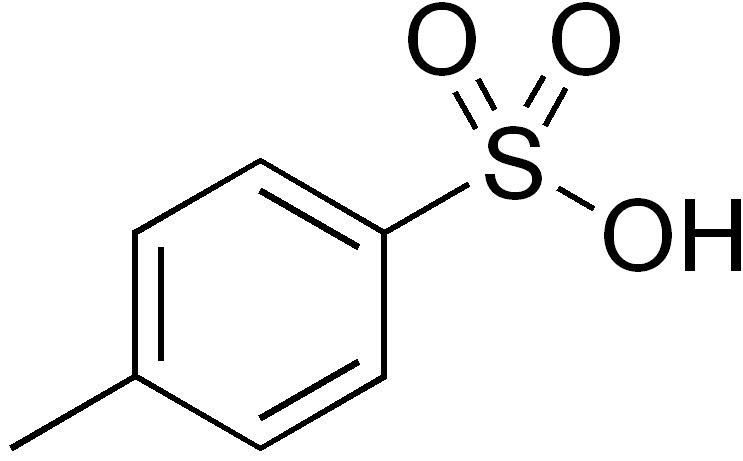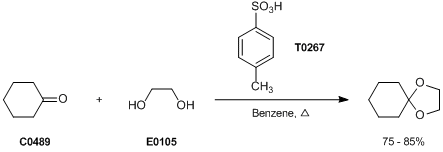Molar mass 172.2 g/mol Density 1.24 g/cm³ Classification Sulfonic acid | Formula CH3C6H4SO3H Melting point 38 °C Appearance colorless (white) solid | |
 | ||
Related sulfonic acids | ||
Synthesis of p toluenesulfonic acid monohydrate
p-Toluenesulfonic acid (PTSA or pTsOH) or tosylic acid (TsOH) is an organic compound with the formula CH3C6H4SO3H. It is a white solid that is soluble in water, alcohols, and other polar organic solvents. The CH3C6H4SO2– group is known as the tosyl group and is often abbreviated as Ts or Tos. Most often, TsOH refers to the monohydrate, TsOH.H2O.
Contents
- Synthesis of p toluenesulfonic acid monohydrate
- P toluenesulfonic acid
- Preparation and handling
- Tosylate esters
- Reactions
- References

As with other sulfonic acids, TsOH is a strong organic acid. It is about one million times stronger than benzoic acid. It is one of the few strong acids that is solid and, hence, conveniently weighed. Also, unlike some strong mineral acids (especially nitric acid, sulfuric acid, and perchloric acid), TsOH is non-oxidizing.

P toluenesulfonic acid
Preparation and handling

TsOH is prepared on an industrial scale by the sulfonation of toluene. It hydrates readily. Common impurities include benzenesulfonic acid and sulfuric acid. Impurities can be removed by recrystallization from its concentrated aqueous solution followed by azeotropic drying with toluene.
TsOH finds use in organic synthesis as an "organic-soluble" acid catalyst. Examples of uses include:
Tosylate esters
Tosylate esters are used as alkylating agents because the tosyl group is electron-withdrawing, which makes the tosylate anion a good leaving group. The tosyl group is also a protecting group for alcohols and amines, prepared by combining the alcohol with 4-toluenesulfonyl chloride, usually in an aprotic solvent, often pyridine, the basicity of which activates the reaction. Toluenesulfonate esters undergo nucleophilic attack or elimination. Reduction of tosylate esters gives the hydrocarbon. Thus, tosylation followed by reduction allows for the deoxygenation of alcohols.
Reactions
This reaction is general for aryl sulfonic acids, but the rate at which it occurs depends upon the structure of the acid, the temperature and the nature of the catalyzing acid. For example, TsOH is unaffected by cold concentrated hydrochloric acid, but hydrolyzes when heated to 186 °C in concentrated phosphoric acid.
